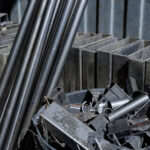The construction industry has witnessed a significant transformation over the years, with the advent of new materials and technologies. Among these, Advanced High-Strength Steel (AHSS) stands out as a revolutionary material, reshaping modern building design with its exceptional properties and versatility. This blog post delves into the world of AHSS, exploring its role in modern architecture and its impact on the future of construction.
Understanding Advanced High-Strength Steel (AHSS) and Its Properties
What is Advanced High-Strength Steel?
Advanced High-Strength Steel (AHSS) is a type of steel that offers a superior strength-to-weight ratio compared to traditional steel grades. It is engineered to provide enhanced mechanical properties and greater resistance to corrosion and wear.
Key Properties of AHSS
AHSS is characterized by its remarkable strength, which allows for thinner, lighter steel sections in construction without compromising structural integrity. Its ductility, weldability, and formability make it an ideal material for complex architectural designs. Additionally, AHSS exhibits excellent fatigue and impact resistance, making structures safer and more durable.
The Evolution of Steel in Construction: From Traditional to Advanced
The Journey from Traditional Steel to AHSS
The evolution of steel in the construction industry has been marked by continuous innovation. Traditional steel, while foundational to early modern architecture, had limitations in strength and flexibility. The development of AHSS addressed these challenges, offering enhanced performance and enabling more ambitious architectural projects.
Impact on the Construction Industry
The introduction of AHSS has revolutionized the construction industry. It has allowed architects and engineers to push the boundaries of design, creating structures that were once deemed impossible. The use of AHSS leads to reduced material usage, lower transportation costs, and faster construction times, significantly impacting the economics of building projects.
Case Studies: Iconic Structures Utilizing AHSS
Examples of AHSS in Modern Architecture
Several iconic structures around the world showcase the capabilities of AHSS. These include:
- The Shard, London: This skyscraper utilizes AHSS in its spire, combining strength with a slender and elegant design.
- Beijing National Stadium (Bird’s Nest): AHSS was crucial in creating the stadium’s intricate and visually stunning steel lattice structure.
Highlighting Structural Engineering Feats
These case studies demonstrate how AHSS has enabled structural engineering feats, creating buildings that are not only aesthetically pleasing but also structurally sound and efficient.
The Benefits of AHSS in Sustainable Building Practices
Advanced High-Strength Steel (AHSS) is not just revolutionizing the construction industry with its strength and flexibility; it’s also paving the way for more sustainable and eco-friendly building practices. Its unique properties offer significant environmental benefits, making it a preferred choice for green construction.
Enhancing Eco-Friendly Construction
Minimizing Environmental Impact
One of the primary advantages of AHSS in sustainable construction is its ability to minimize the environmental impact of buildings. The superior strength of AHSS means that less material is required to achieve the same structural performance as traditional steel. This reduction in material usage not only decreases the weight and cost of steel structures but also lessens the environmental burden associated with the extraction, processing, and transportation of raw materials.
Recyclability and Lifecycle Sustainability
Steel’s capacity for recycling is well-known, and AHSS is no exception. It can be recycled indefinitely without loss of quality, making it a sustainable material choice throughout its lifecycle. The recyclability of AHSS ensures that the material can be reused in new construction projects, thereby reducing the demand for virgin raw materials and conserving natural resources.
Energy Efficiency and Durability
Improved Energy Efficiency in Buildings
AHSS contributes to the energy efficiency of buildings in several ways. Its lighter weight reduces the load on building foundations and structures, allowing for more efficient design and use of materials. This lightness translates to buildings that require less energy for heating and cooling. In an era where energy efficiency is paramount for environmental sustainability, AHSS plays a crucial role in reducing the carbon footprint of new buildings.
Enhanced Building Durability
The durability of AHSS is another factor that contributes to its sustainability. Buildings constructed with AHSS have longer life spans and require fewer repairs and maintenance over time. This longevity means that the resources invested in the building yield benefits for a longer period, enhancing the overall sustainability of the construction. Moreover, the reduced need for frequent renovations or rebuilds cuts down on waste generation and resource consumption, further contributing to the environmental friendliness of AHSS.
Cost-Effectiveness and Resource Conservation
Reducing Construction Costs
The use of AHSS can lead to significant cost savings in construction. The reduced weight of AHSS lowers transportation and handling costs, and its ease of installation can shorten construction timelines, further reducing labor costs.
Conserving Resources and Reducing Waste
By requiring less material for construction, AHSS helps conserve valuable resources. This conservation is increasingly important in a world where sustainable resource management is crucial. Additionally, the reduced waste associated with AHSS use, due to its recyclability and longer lifespan, means that construction projects can achieve a smaller environmental footprint.
Supporting Green Building Certifications
Meeting Green Building Standards
The use of AHSS can contribute to a building’s ability to meet various green building standards and certifications, such as LEED (Leadership in Energy and Environmental Design). Its attributes align with the criteria for sustainable materials, energy efficiency, and resource conservation, making it an excellent material choice for projects aiming for these certifications.
Advanced High-Strength Steel is a key player in the movement towards more sustainable and eco-friendly construction practices. Its combination of strength, durability, and recyclability, along with its contributions to energy efficiency and resource conservation, make it an ideal choice for modern, sustainable building projects. As the construction industry continues to evolve towards greener practices, AHSS will undoubtedly play a central role in shaping a more sustainable future. For companies like Pride Metals, leveraging the benefits of AHSS is not only a commitment to innovation but also to environmental stewardship and sustainable development.
Future Trends: AHSS and the Changing Face of Urban Architecture
Predicting the Future of Construction with AHSS
The future of urban architecture with AHSS is promising. As cities continue to grow and the demand for innovative and sustainable building solutions increases, AHSS is expected to play a pivotal role in meeting these challenges.
Innovations in Construction Technology
Advancements in construction technology, such as 3D printing and modular construction, are likely to integrate seamlessly with AHSS, further enhancing its application and efficiency in building design.
Advanced High-Strength Steel is not just a material but a cornerstone of modern architectural innovation. Its unique properties and versatility make it an indispensable component in the construction industry, paving the way for more sustainable, efficient, and awe-inspiring buildings.
As we look to the future, AHSS will undoubtedly continue to shape the skyline of cities around the world, reflecting the ever-evolving nature of human ingenuity in architecture.
For Pride Metals, staying at the forefront of this revolution means continuously embracing and integrating these advancements into our practices, driving the industry forward into a new era of construction excellence.







